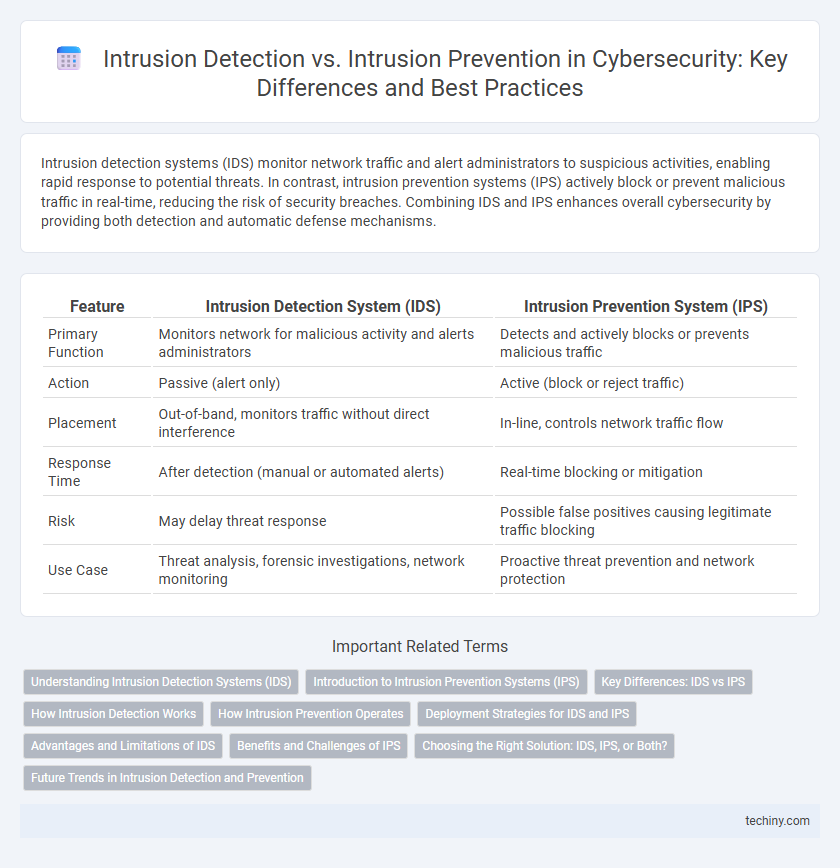Intrusion detection systems (IDS) monitor network traffic and alert administrators to suspicious activities, enabling rapid response to potential threats. In contrast, intrusion prevention systems (IPS) actively block or prevent malicious traffic in real-time, reducing the risk of security breaches. Combining IDS and IPS enhances overall cybersecurity by providing both detection and automatic defense mechanisms.
Table of Comparison
| Feature | Intrusion Detection System (IDS) | Intrusion Prevention System (IPS) |
|---|---|---|
| Primary Function | Monitors network for malicious activity and alerts administrators | Detects and actively blocks or prevents malicious traffic |
| Action | Passive (alert only) | Active (block or reject traffic) |
| Placement | Out-of-band, monitors traffic without direct interference | In-line, controls network traffic flow |
| Response Time | After detection (manual or automated alerts) | Real-time blocking or mitigation |
| Risk | May delay threat response | Possible false positives causing legitimate traffic blocking |
| Use Case | Threat analysis, forensic investigations, network monitoring | Proactive threat prevention and network protection |
Understanding Intrusion Detection Systems (IDS)
Intrusion Detection Systems (IDS) monitor network traffic for suspicious activities and generate alerts when potential threats are identified, functioning as a crucial component in cybersecurity defenses. Unlike Intrusion Prevention Systems (IPS), which actively block malicious traffic, IDS provide detailed analysis and help security teams respond to incidents more effectively. Advanced IDS employ techniques like signature-based detection, anomaly detection, and machine learning to enhance accuracy in identifying cyberattacks and potential breaches.
Introduction to Intrusion Prevention Systems (IPS)
Intrusion Prevention Systems (IPS) actively monitor network traffic to detect and block malicious activities in real-time, enhancing security beyond traditional Intrusion Detection Systems (IDS) that only alert administrators. IPS utilize signature-based, anomaly-based, and policy-based detection methods to identify threats such as malware, denial-of-service attacks, and unauthorized access attempts. Integrating IPS into network security frameworks significantly reduces response times and mitigates potential breaches by preventing attacks before they reach critical systems.
Key Differences: IDS vs IPS
Intrusion Detection Systems (IDS) monitor network traffic for suspicious activity and generate alerts without taking direct action to block threats, while Intrusion Prevention Systems (IPS) not only detect threats but automatically intervene to block or mitigate attacks in real-time. IDS operates in a passive mode, analyzing traffic and providing insights for further investigation, whereas IPS functions inline within the network, actively preventing malicious packets from reaching their target. The key difference lies in IDS's role as a detection and alert tool versus IPS's proactive defense mechanism that enforces network security policies by stopping attacks before they cause harm.
How Intrusion Detection Works
Intrusion Detection Systems (IDS) monitor network traffic and system activities to identify suspicious patterns indicating potential threats or unauthorized access. By analyzing data packets and comparing them against known attack signatures or abnormal behavior profiles, IDS can detect malware, hacking attempts, and policy violations. Once identified, alerts are generated for security teams to investigate and respond, ensuring threats are addressed without actively blocking traffic.
How Intrusion Prevention Operates
Intrusion prevention systems (IPS) actively monitor network traffic in real time to identify and block malicious activities before they can cause harm, using signature-based and anomaly-based detection methods. They automatically enforce security policies by analyzing data packets and dropping those that contain suspicious or known attack patterns, effectively preventing breaches. By integrating deeply with firewalls and network devices, IPS provides a proactive defense layer that stops threats earlier than intrusion detection systems (IDS), which only alert administrators without taking direct action.
Deployment Strategies for IDS and IPS
Intrusion Detection Systems (IDS) are typically deployed in a passive manner, monitoring network traffic and alerting administrators to suspicious activities without interfering with data flow, making them ideal for environments requiring detailed analysis and minimal disruption. Intrusion Prevention Systems (IPS) are positioned inline within the network, actively blocking or mitigating threats in real time to prevent unauthorized access or damage, which is crucial for high-security environments demanding immediate response. Hybrid deployment strategies combine IDS and IPS to balance comprehensive monitoring with proactive threat prevention, optimizing overall network security posture while reducing false positives and operational overhead.
Advantages and Limitations of IDS
Intrusion Detection Systems (IDS) offer robust monitoring capabilities by analyzing network traffic and system activities to detect malicious behavior and alert administrators in real time, enhancing overall security awareness. Their advantages include the ability to identify previously unknown threats through anomaly detection and minimal disruption to network performance. However, IDS have limitations such as generating false positives, requiring skilled personnel for accurate analysis, and lacking the capability to actively block threats, which may delay response times.
Benefits and Challenges of IPS
Intrusion Prevention Systems (IPS) offer real-time threat blocking capabilities that enhance network security by stopping attacks before they can cause damage, reducing false positives compared to Intrusion Detection Systems (IDS). The key benefits include automated response, continuous monitoring, and the ability to enforce security policies without human intervention. Challenges involve potential network latency, complexity in accurately configuring rules to avoid blocking legitimate traffic, and the requirement for regular updates to keep pace with evolving cyber threats.
Choosing the Right Solution: IDS, IPS, or Both?
Selecting the right cybersecurity solution hinges on the specific needs of a network, balancing between Intrusion Detection Systems (IDS) and Intrusion Prevention Systems (IPS). IDS excels in monitoring network traffic and alerting administrators to potential threats without directly interfering, ideal for environments prioritizing visibility and analysis. IPS actively blocks malicious activities in real-time, providing proactive defense, while combining both offers comprehensive protection by detecting and preventing threats simultaneously, crucial for high-security networks.
Future Trends in Intrusion Detection and Prevention
Future trends in intrusion detection and prevention emphasize advanced machine learning algorithms that enhance threat accuracy and reduce false positives. Integration of artificial intelligence with real-time threat intelligence enables proactive defense mechanisms against evolving cyber threats. Cloud-native security solutions and automated response systems are becoming standard to address the increasing complexity of network environments.
intrusion detection vs intrusion prevention Infographic

 techiny.com
techiny.com